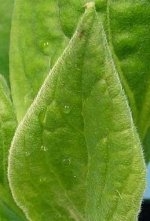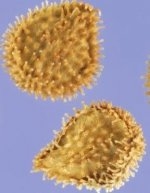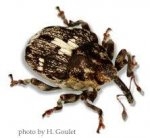Hound's Tongue
Cynoglossum officinale 
Overview
Originated from Eurasia Hound's Tongue was accidently introduced to North America as a seed contaminant of cereal seeds in the early 1900's.
Hound's Tongue is a weak competitor and requires disturbance to become established. Cattle loafing areas and wallows are a common starting point for infestations, healthy rangelands will be resistant to an invasion. Once an area has been infected Hound's Tongue will quickly colonize the area and form dense monocultures. This hinders the growth of desirable rangeland species and thus decreases the available forage for livestock.
The plant contains poisonous alkaloids, animals don't forage on the fresh plants but if it's mixed with hay it can cause sever liver failure. Fatal liver disease has occurred in horses that have feed on hay with as little as 6% Hound's Tongue over a course of 2 weeks.
Habitat
This plant can survive hot summers and clod winters, it's shade tolerant and can grow in a variety of soils; from alkaline to clay and it thrives in wet grasslands.
Hound's Tongue can be seen growing in rangelands, pastures, abandoned crop lands, roadsides, and disturbed forested areas.
Identification
Hound's Tongue can either be a biennial or short lived perennial. A basal rosette is formed in the first year and flowers in the 2nd. There can be multiple stems that can grow 1.5 m tall. Leaves are alternate and oblong and hairy resembling a Hound's Tongue.
Houndstongue leaf
Flowers are reddish-purple in colour have five petals and appear from May to July. Seeds are called nutlets and are covered in barbs that allow them to easily stick to fur, hair and clothes which allows for dispersal to new areas for invasion. The nutlets reduce the sale value of livestock, stress the animals and causes irritation and behavioural problems in cattle.
One plant can produce more than 500 seeds and the seeds remain viable for 2-3 years on the soil surface, but if buried they will rarely survive more than a year.
 Hound's Tongue nutlets
Hound's Tongue nutlets
Prevention
Because this plant can only reproduce by seed preventing flowering is the most effective way to prevent the spread of this plant to new areas.
Hand pulling is effective in small areas before the seed stage is also effective or cutting the roots below the ground. Mowing low to the ground is only effective in the second year of growth and prevents seeding.
Biocontrol is being done in British Columbian and Alberta and has shown positive results, the insect being used in the root mining weevil Monglones cruciger.

Information obtain from Montana State University Extensions: Houndstongue: Indentification, Biology & Integrated Management and The Alberta Invasive Plant Council
Â
Resources
Hound's Tongue ISCM Fact Sheet
Alberta Invasive Plant Council Fact Sheet
Â
Â
Back to Terrestrial Invasive Species List
Â
© Copyright 2004-2025 - CMS Made Simple
This site is powered by CMS Made Simple version 1.4.1


